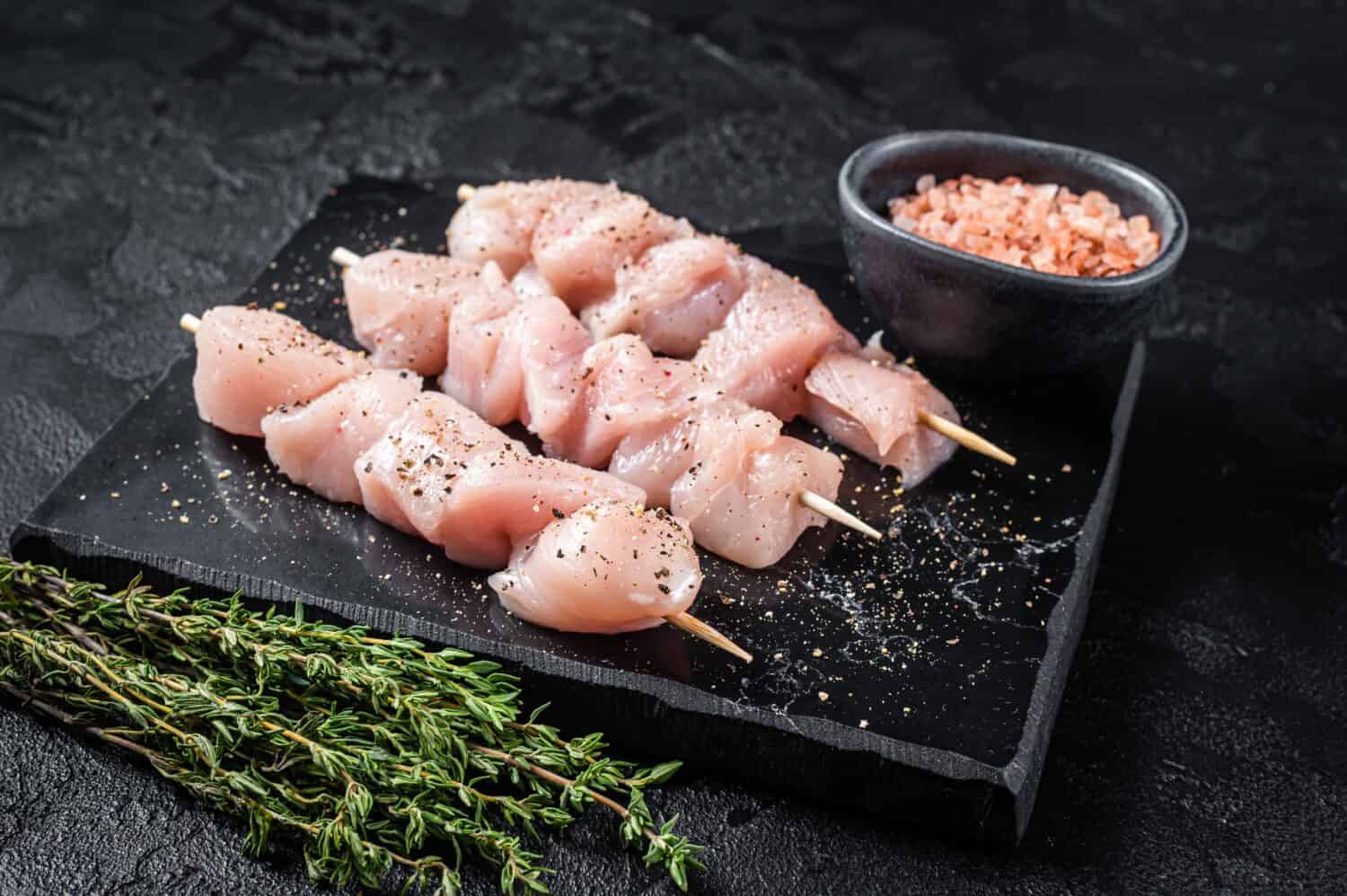As parents, we strive to provide our children with healthy and nutritious meals, and chicken often finds its way to the top of the menu. Whether it's a succulent roasted chicken dinner or a quick stir-fry, this versatile protein is a household favorite. However, it's important to understand the differences between cooked and uncooked chicken for the safety and well-being of our family.
There are many differences between cooked and uncooked chicken, including taste, texture, and appearance. The biggest difference between the two, however, is the color. Cooked chicken will be white or tan in color with no traces of pink, while uncooked chicken will be noticeably pink.
In this post, we'll uncover the in-depth contrasts between cooked and uncooked chicken, shedding light on everything from appearance and flavor to nutritional profiles and the importance of proper cooking techniques. By understanding these differentiations, we can ensure the safety of our family while also enjoying delicious chicken-based dishes. So let's dive in and explore the world of cooked and uncooked chicken!
Cooked vs. Uncooked Chicken: What are the Differences?
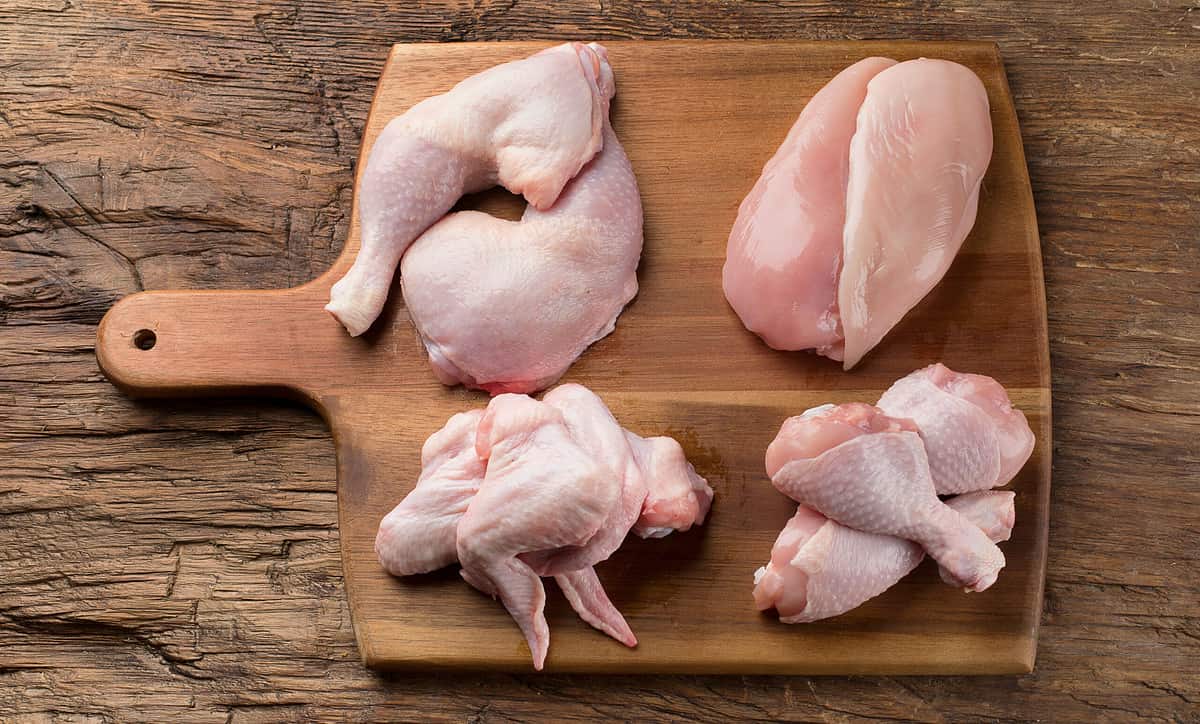
©Tatjana Baibakova/Shutterstock.com
As mentioned, one of the key differences between cooked and uncooked chicken is the change in color from pink to white. But there are other variations like the texture, flavor, and safety of cooked vs. uncooked chicken as well. Let's take a closer look at what sets these two apart and how you can tell if your chicken is undercooked or cooked to perfection.
- The must-have convenient reference guide for every home cook!
- Includes more than 8,000 substitutions for ingredients, cookware, and techniques.
- Save time and money on by avoiding trips to grab that "missing" ingredient you don't really need.
Appearance and Texture
Cooked chicken has a firm texture and often changes color, depending on the cooking method used. The meat may turn white, golden brown, or have a charred appearance, depending on how it was prepared. Uncooked chicken, on the other hand, has a soft and flexible texture. It appears pinkish or pale in color, with a smooth surface. Keep in mind that the texture can vary depending on the cut and quality of the chicken.
Flavor
Cooked chicken develops a rich and savory flavor during the cooking process. Depending on how it's prepared and the seasoning used, it may have a slightly smoky, roasted, or grilled taste. Uncooked chicken does not have a distinct flavor, but it may carry a mild poultry aroma. The true flavors are only developed when the chicken is cooked and seasoned.
Food Safety
According to USDA recommendations, properly cooked chicken is considered safe to eat as long as it reaches an internal temperature of at least 165°F (74°C). Cooking chicken to this temperature helps eliminate harmful bacteria which can cause food poisoning.
Uncooked chicken carries a higher risk of bacterial contamination, especially with Salmonella and Campylobacter. These bacteria are commonly found in poultry and can lead to foodborne illnesses if consumed raw or undercooked. It is crucial to handle uncooked chicken with care to prevent cross-contamination and ensure thorough cooking.
Cooked vs. Uncooked Chicken: Nutritional Value
The nutritional profile of cooked chicken can vary depending on the cooking method and whether or not you consume the skin. It remains an excellent source of high-quality protein, essential amino acids, vitamins (B6, B12), minerals (iron, zinc), and healthy fats (especially in the skin).
The nutritional composition of uncooked chicken is similar to that of cooked chicken. However, consuming raw chicken presents an increased risk of bacterial contamination, which can lead to foodborne illnesses.
The National Chicken Council provides an in-depth look at the nutritional value of cooked chicken. Boneless, skinless chicken breast is often viewed as the healthiest option as it only contains 165 calories and 3.57 g of fat, but still 31.02 g of protein. On the opposite end of the spectrum, a whole chicken including light meat, dark meat, and the skin comes in at 239 calories per serving and 13.6 g of fat with only 27.3 g of protein.
Guidelines to Make Sure Chicken is Fully Cooked
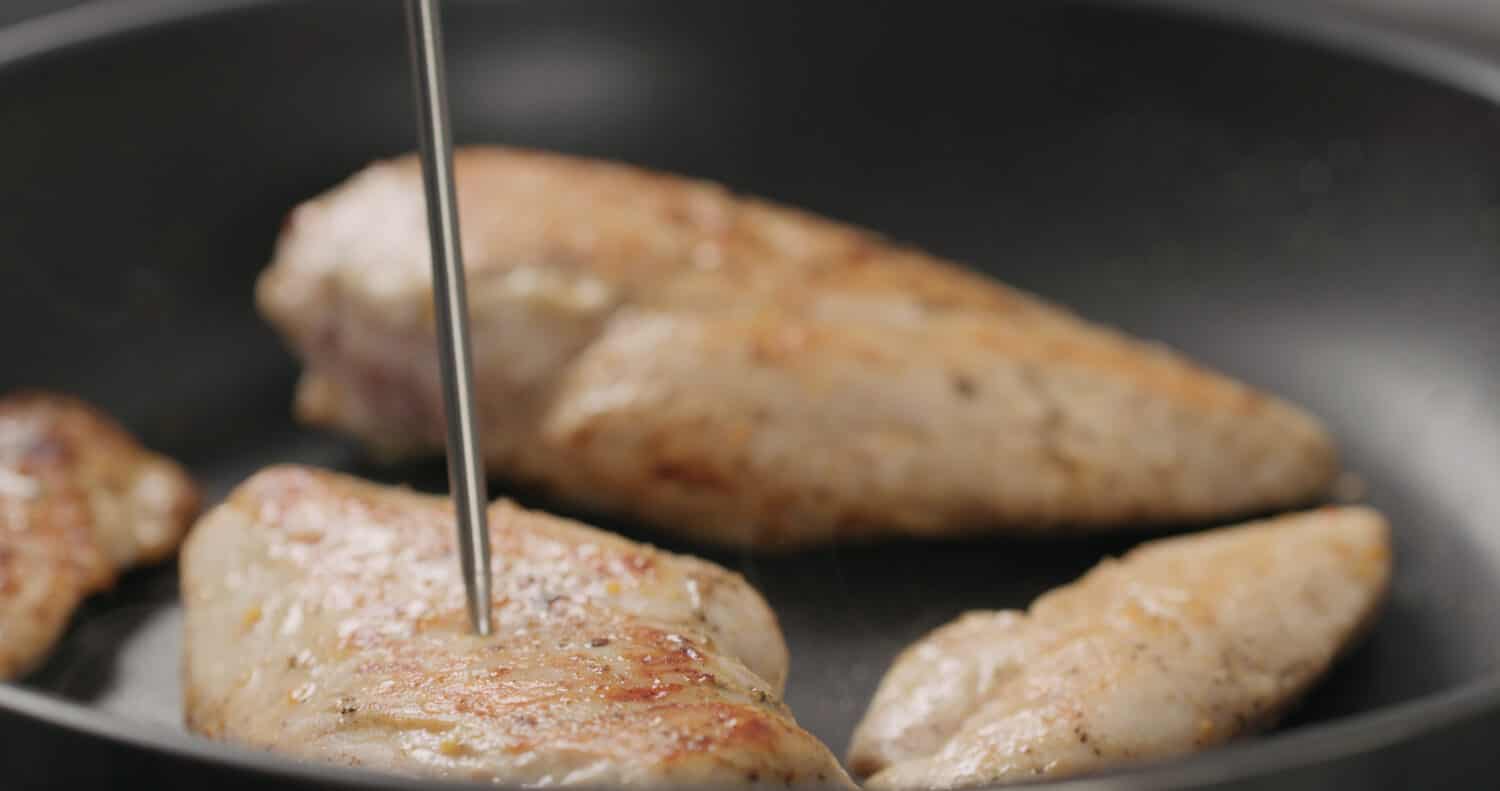
©GCapture/Shutterstock.com
Being able to tell the difference between cooked and uncooked chicken is, of course, crucial to food safety in the kitchen. But how do you make sure your chicken really is fully cooked and you're not serving undercooked poultry at your next family meal?
Use a Meat Thermometer
This is one of the safest and easiest ways to ensure your chicken is fully cooked. Oftentimes, the outside of the chicken will appear done, while the inside is still pink and undercooked. By inserting a thermometer to make sure your chicken is cooked to the 165°F USDA recommendation, you can feel safe serving the chicken to your family.
Check the Color and Texture
While color and texture can provide some indication of doneness, they are not always reliable on their own. Cooked chicken should have an opaque white or tan color throughout, with no traces of pink or rawness. The texture should also be firm.
Follow Cooking Times
Cooking times may vary depending on the cut and size of the chicken, as well as the cooking method. It's important to follow recommended cooking times and temperatures for various chicken dishes. Refer to recipe instructions or reputable cooking resources to ensure proper cooking times are followed.
Check the Juices
When cutting into your cooked chicken, the juices should run clear, not pink or red. Colored juices may indicate that the chicken is not fully cooked and needs more time.
Use a Resting Period
After cooking, allow the chicken to rest for a few minutes before cutting it. This helps the juices redistribute, resulting in a more flavorful and moist chicken.
By following these steps and using a food thermometer as your primary guide, you can confidently ensure that your chicken is cooked thoroughly, safe to eat, and free from harmful bacteria.
- The must-have convenient reference guide for every home cook!
- Includes more than 8,000 substitutions for ingredients, cookware, and techniques.
- Save time and money on by avoiding trips to grab that "missing" ingredient you don't really need.
Cooking Methods to Ensure Fully Cooked Chicken
There are many different ways to cook chicken. Here are a few ways to ensure you're fully cooking your chicken using the most popular methods.
Oven and Stovetop Cooking
When cooking chicken in the oven, preheat it to the recommended temperature and place the chicken on a baking sheet or in a roasting pan. Cook until the internal temperature reaches the recommended 165°F. For stovetop cooking methods like sautéing or pan-frying, cook until the chicken is no longer pink in the center and the juices run clear.
Grilling and Barbecuing
When grilling or barbecuing chicken, preheat the grill to medium-high heat. Place the chicken on the grill and cook with the lid closed. Turn the chicken occasionally to ensure even cooking. Again, use a food thermometer to check that the internal temperature has reached 165°F.
Boiling
Boiling or simmering chicken is often used for soups, stews, and shredded chicken dishes. To ensure the chicken is fully cooked, bring the liquid to a boil, add the chicken, and reduce the heat to a simmer. Cook until the internal temperature reaches 165°F.
Stir-Frying
Stir-frying chicken involves quickly cooking it in a hot skillet or wok with high heat. To ensure the chicken is fully cooked, cut it into small, evenly-sized pieces. Cook the chicken over high heat, stirring continuously until it is no longer pink in the center. A food thermometer can again be used to ensure each piece reaches the recommended 165°F.
Chicken Recipes
You need to try this great slow-cooked chicken recipe, along with these other suggestions:
Print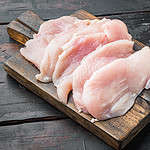
Slow-cooked Chicken
Ingredients
4 medium carrots, cut into 2 inch pieces
1 medium onion, chopped
1 celery rib, cut into 2 inch pieces
2 cups cut fresh green beans (2 inch pieces)
5 small red potatoes, quartered
1 broiler/fryer chicken (3 to 3½ pounds), cut up
4 bacon strips, cooked and crumbled
1½ cups hot water
2 teaspoons chicken bouillon granules
1 teaspoon salt
½ teaspoon dried thyme
½ teaspoon dried basil
Pinch pepper
Instructions
1. In a 5 qt. slow cooker, layer the first seven Ingredients: in order listed.
2. In a small bowl, combine the water, bouillon, salt, thyme, basil, and pepper; pour over the top. Do not stir.
3. Cover and cook on low for 6 to 8 hours or until vegetables are tender and chicken juices run clear.
4. Remove chicken and vegetables. Thicken cooking juices for gravy if desired.
- Basil Garlic Whole Chicken with Vegetables
- Baked Chicken Nuggets
- Four to Five Ingredient Chicken Recipes
- Crock Pot Chicken Recipes
Final Thoughts
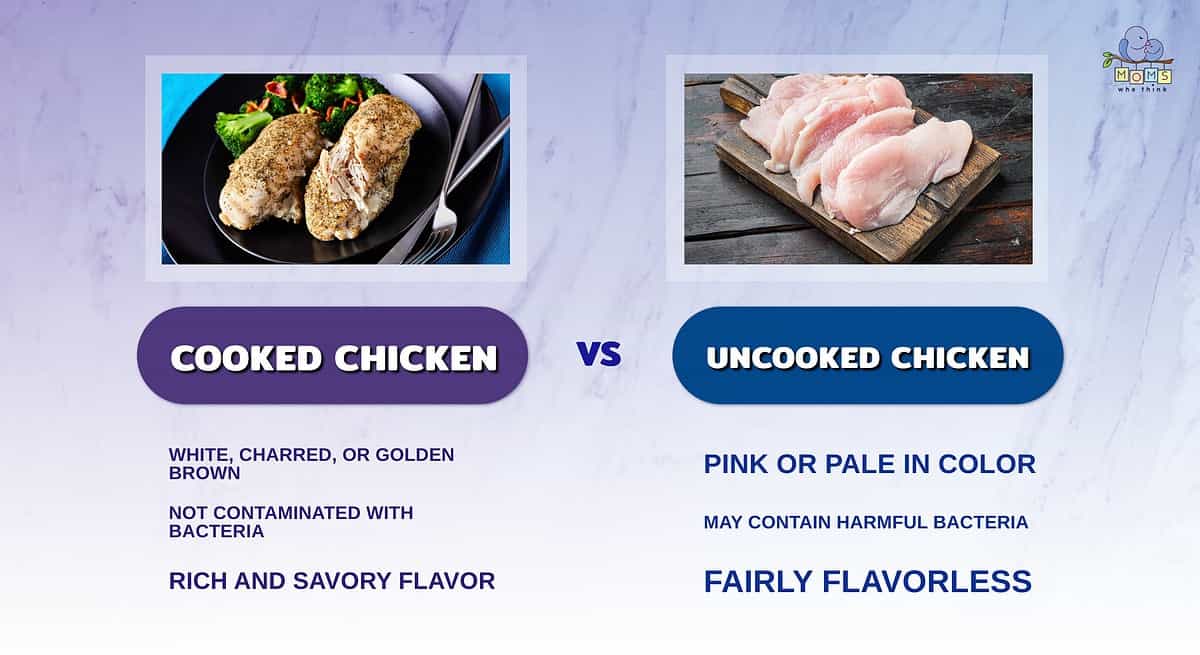
- Cooked chicken is white, golden brown, or charred in appearance. Uncooked chicken is fairly recognizable by its pink or pale appearance.
- Uncooked chicken may contain harmful bacteria that can make you ill. By cooking the chicken, you'll kill off this bacteria and make it safe to eat.
- Cooked chicken has a rich and savory flavor that can vary depending on the seasonings used. Uncooked chicken is virtually flavorless.
In conclusion, understanding the differences between cooked and uncooked chicken is crucial for the well-being of our families. While chicken remains a popular protein choice in our kitchens, it's important to understand the significance of proper cooking techniques and food safety measures. From the visible differences in color, texture, and taste to the hidden risks of bacterial contamination, these factors play a vital role in ensuring that our meals are both delicious and safe.
The image featured at the top of this post is ©Mironov Vladimir/Shutterstock.com.
- The must-have convenient reference guide for every home cook!
- Includes more than 8,000 substitutions for ingredients, cookware, and techniques.
- Save time and money on by avoiding trips to grab that "missing" ingredient you don't really need.
